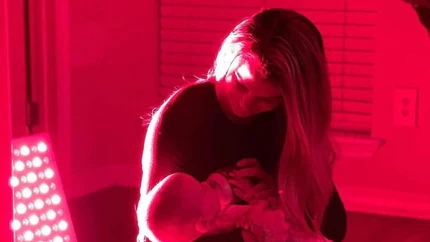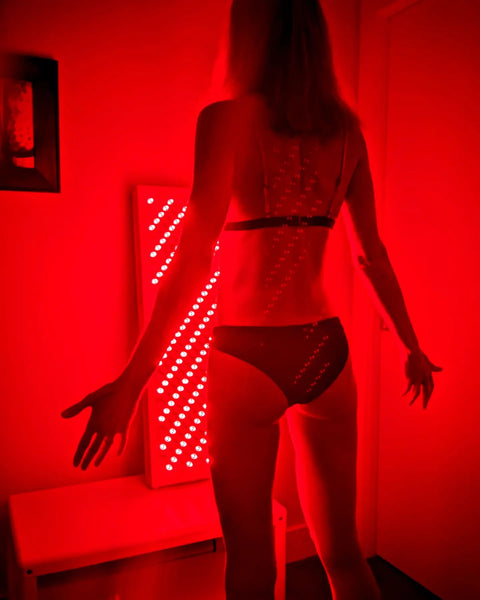
Unlocking Female Fertility: The Benefits of Red Light Therapy
Boosting Fertility with Red Light Therapy
If you're looking for ways to boost fertility, you might be surprised to learn that Red Light Therapy (RLT) could help. While it's often used for skin health and pain relief, RLT is showing potential in improving fertility too. By increasing blood flow, reducing inflammation, and supporting healthy cells, this simple therapy might be a great addition to your fertility journey.
Let’s dive into how Red Light Therapy for fertility and conception works and how it can help support reproductive health for both men and women.
What is Red Light Therapy?
Red Light Therapy (RLT) is a non-invasive treatment that uses low-level red and near-infrared light to improve cellular function. The light penetrates the skin to energize cells, promoting healing, reducing inflammation, and enhancing circulation. It's commonly used to treat various health issues like skin conditions, muscle recovery, and now, fertility.
The therapy works by stimulating the mitochondria in your cells—these are the energy producers that help your body function at its best. When cells have more energy, they can repair and regenerate faster, which is beneficial for overall health and, potentially, reproductive health.
Benefits of Red Light Therapy:
- Boosts circulation and blood flow to vital organs
- Reduces inflammation and oxidative stress
- Enhances cellular energy and repair
The Connection Between Red Light Therapy and Fertility
Red Light Therapy’s benefits extend beyond skin health and muscle recovery; it’s now being explored for its potential to support reproductive health. By improving cellular energy, increasing blood flow, and reducing inflammation, RLT may help create a more fertile environment for both men and women.
How Red Light Therapy May Improve Female Fertility
Red Light Therapy for female fertility may help in several ways:
- Improved blood flow to reproductive organs: low level laser therapy enhances circulation, delivering more oxygen and nutrients to the ovaries and uterus, which may help improve egg quality and uterine health.
- Hormonal balance: Red Light Therapy may support a healthy hormone balance, which is essential for ovulation and maintaining a healthy reproductive system.
- Reduced inflammation: Conditions like PCOS and endometriosis can cause inflammation in the reproductive organs. RLT may help reduce this inflammation, improving overall fertility.
How Red Light Therapy May Improve Male Fertility
For men, near-infrared Light Therapy can help by:
- Increasing sperm quality: Studies suggest that red led light may improve sperm count, motility, and overall sperm health by boosting cellular energy in reproductive tissues.
- Reducing oxidative stress: RLT reduces oxidative stress in the body, which can damage sperm cells and affect fertility.
Scientific Studies on Red Light Therapy for Fertility
Though research on Infrared Light Therapy (RLT) and fertility is still developing, early studies have shown promising results.
-
For women: A study in Denmark found that women with fertility challenges, especially those with poor ovarian function, had higher conception rates after using laser light. This was likely due to improved blood flow to the ovaries and uterus.
-
For men: Research indicates that RLT can boost sperm health, improving sperm motility and count by reducing oxidative stress and increasing cellular energy.
How to Use Red Light Therapy for Fertility
Using red and near infrared light to support fertility is simple and can be done either at home with a personal device or in a clinical setting. The key is consistency and targeting the right areas.
Frequency and Duration
- Home Use: Most experts recommend using RLT for about 10-20 minutes per session, 3-5 times a week, focusing on the lower abdomen for women or pelvic area for men.
- Clinic Use: In a professional setting, treatments may be more powerful and longer but follow similar schedules.
Where to Target
- For women: Focus the light on the lower abdomen to promote better blood flow to the ovaries and uterus.
- For men: Target the pelvic area to improve sperm production and reproductive organ health.
Tips for Using RLT:
- Stay consistent with treatments over several weeks to see results.
- Use a high-quality RLT device with proper wavelengths (600-900 nm range).
- Consult with a healthcare provider to ensure the therapy fits into your fertility plan.
Best Red Light Therapy Devices for Fertility
For those looking to incorporate Red Light Therapy (RLT) into their fertility journey, KOZE Health offers high-quality devices that are both effective and user-friendly. Here are some of the top options from KOZE Health:
Top KOZE Health Red Light Therapy Devices:
- Light Wavelengths: 660 nm red light and 850 nm near-infrared light
- Best For: Targeted areas like the lower abdomen, suitable for home use
- Pros: Compact, powerful, and easy to integrate into a daily routine
- Device Link: KOZE S Series
- Light Wavelengths: 660 nm and 850 nm
- Best For: Full-body treatment and consistent use
- Pros: High power output, sleek design, and ideal for comprehensive home therapy
- Device Link: KOZE X Series (White)
- Light Wavelengths: 660 nm and 850 nm
- Best For: Versatile use, with a focus on both targeted and full-body treatments
- Pros: Stylish, easy to use, and effective for improving overall reproductive health
- Device Link: KOZE S Series (Black)
Other Health Benefits of Red Light Therapy That May Support Fertility
Beyond fertility, photobiomodulation therapy offers a range of health benefits that can indirectly support reproductive health. By improving overall wellness, RLT helps create an optimal environment for fertility by boosting vital bodily functions and reducing stress.
Key Health Benefits:
-
Improved Sleep Quality
RLT helps regulate the body’s circadian rhythm, promoting better sleep. Quality sleep is crucial for hormone regulation, which plays a big role in fertility. -
Reduced Stress and Anxiety
Stress can negatively impact fertility by disrupting hormone balance. RLT can help reduce stress levels by promoting relaxation and reducing inflammation, which may support a healthier reproductive system. -
Enhanced Cellular Repair and Recovery
By increasing ATP production, RLT enhances cellular regeneration and recovery, leading to better overall health. This cellular repair can positively influence reproductive organ function. -
Better Blood Circulation
Improved blood flow means that more oxygen and nutrients are delivered to vital organs, including the reproductive system. This can help improve egg and sperm quality and overall reproductive health.
Table: Health Benefits That Support Fertility
| Health Benefit | How It Supports Fertility |
|---|---|
| Improved Sleep | Regulates hormones essential for reproduction |
| Reduced Stress | Balances reproductive hormones, reduces inflammation |
| Cellular Repair | Improves reproductive organ function |
| Increased Circulation | Enhances egg/sperm quality and overall fertility |
Are There Any Risks or Side Effects of Using Red Light Therapy for Fertility?
While Red Light Therapy (RLT) is generally considered safe, it's important to be aware of potential risks and side effects, especially when using it to support fertility. The good news is that side effects are rare and usually mild, but it's always wise to proceed with caution.
Common Side Effects:
- Skin Irritation: Some people may experience mild redness or irritation in the area where the light is applied. This is usually temporary and goes away on its own.
- Eye Safety: Direct exposure to the eyes should be avoided, as the light can be harmful. Always wear protective eyewear during treatment.
Is It Safe to Use RLT While Trying to Conceive?
There is no conclusive evidence that Red Light Therapy negatively impacts conception efforts. However, it's recommended to consult with a healthcare provider before beginning RLT, especially if you are undergoing other fertility treatments like IVF or using medication.
Precautions to Consider:
- Avoid overexposure: Stick to recommended treatment times (usually 10-20 minutes per session) to avoid skin irritation or burns.
- Consult your doctor: If you're pregnant or actively trying to conceive, discuss RLT with your healthcare provider to ensure it's safe for your specific situation.
Overall, Red Light Therapy is a low-risk, non-invasive option for those seeking to improve their success rate on fertility issues, but taking these precautions ensures a safer experience.
Frequently Asked Questions About Red Light Therapy and Fertility
Here are some common questions people have about using Red Light Therapy (RLT) to support fertility:
1. Can Red Light Therapy really improve fertility?
While research is still ongoing, early studies suggest that Red Light Therapy can improve fertility by boosting cellular energy, reducing inflammation, and improving blood flow to reproductive organs. It has shown positive effects in both men and women by improving egg and sperm quality.
2. How long does it take to see results from RLT for fertility?
Results can vary depending on the individual and the underlying fertility challenges. Most people use Red Light Therapy consistently for several weeks (3-5 times per week) before noticing improvements. Patience and regular use are key for best results.
3. Is Red Light Therapy treatments safe while trying to conceive?
Yes, RLT is generally safe to use while trying to conceive. It is non-invasive, and side effects are minimal. However, it’s always a good idea to consult with your healthcare provider, especially if you are undergoing other fertility treatments like IVF.
4. Can I use Red Light Therapy during pregnancy?
It’s recommended to consult with your doctor before using Red Light Therapy during pregnancy, as there is limited research on its use in pregnant women. While RLT is typically safe, it’s best to get professional advice for your specific situation.
5. Does Red Light Therapy work for both male and female fertility?
Yes, Red Light Therapy can benefit both men and women. For women, it may improve blood flow to the ovaries and uterus, supporting egg health and hormone balance. For men, it can help improve sperm count, motility, and overall sperm quality by reducing oxidative stress.
Conclusion
Red Light Therapy (RLT) is a type of light that offers a non-invasive, natural way to support fertility by improving cellular health, enhancing blood flow, and reducing inflammation. While research is still emerging, the potential benefits for both men and women make it an exciting option to explore alongside other fertility-boosting practices.
Whether a woman and man are using RLT to improve egg quality, sperm health, or overall reproductive function, incorporating this therapy into your routine can provide a holistic approach to your fertility journey. Remember to combine it with healthy lifestyle choices such as proper nutrition, regular exercise, stress management, and sleep for the best results.
As always, it’s essential to consult with a healthcare provider before starting any new treatment, especially if you are undergoing other fertility treatments. Red Light Therapy could be the extra boost you need to enhance your reproductive health and increase your chances of conception.





